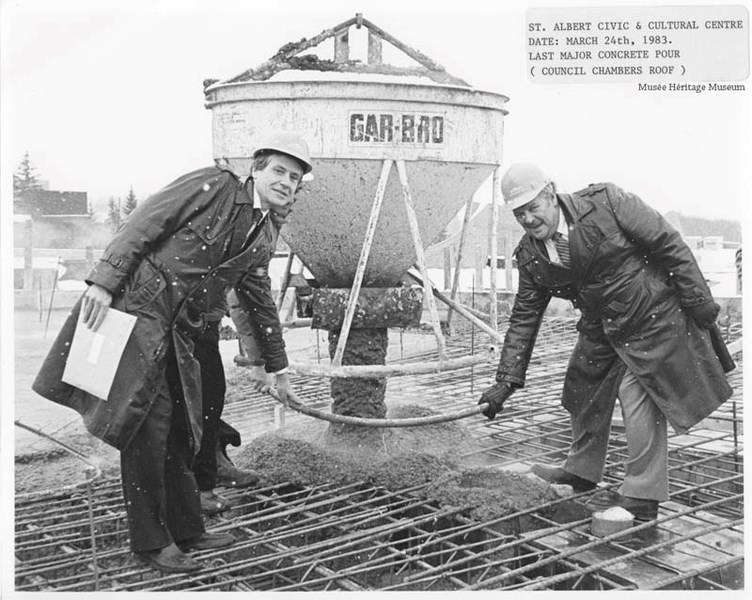The meeting room known around St. Albert Place as the east boardroom will soon be called the Douglas Cardinal Boardroom. St. Albert is honouring the architect who designed the city's iconic civic and cultural centre by naming the recently renovated boardroom after him.
The meeting room known around St. Albert Place as the east boardroom will soon be called the Douglas Cardinal Boardroom.
St. Albert is honouring the architect who designed the city's iconic civic and cultural centre by naming the recently renovated boardroom after him.
“I think it's wonderful. I had a wonderful time serving the people of St. Albert,” Cardinal said when reached at his office in Ottawa.
Earlier this June marked the 30th anniversary of the grand opening of St. Albert Place. Back in 1984 when the building opened, there were thousands of people in attendance. That was a warmer welcome than it had received when the idea was first developed – a plebiscite on the question of building a new civic and cultural centre in October 1980 saw a narrow margin of 318 votes separate the “yeses” from the “nos.”
Carol Watamaniuk, who was the director of culture for the city during the project's development and, later, a member of council, remembers going out to public consultations and promoting the design.
“I went out and literally lobbied for this building as a staff member,” she said, noting that would not be allowed today and did garner her some commentary from the council of the day.
Watamaniuk recalled doing a great deal of research about the cultural aspects that should be included in the new civic building.
The choice eventually came down to Cardinal's design, which Watamaniuk described as “organic,” and another architect's pitch, which she described as “a box.”
“The decision, and I shall be forever grateful to council at that time, decided that the other building was a little bit cheaper but it wasn't St. Albert,” she said. “The organic design won out over the box, thank goodness.”
There have been maintenance issues with the building – even this year, buckets and spouts could be seen addressing leaks from the windows – but Watamaniuk looks past those to the bigger picture.
“I wouldn't change this building for anything. It's always been very special,” she said.
Bill Shields, who was the St. Albert Place ad hoc committee chair and a former alderman, knew of Cardinal's reputation.
“I said I recommend Doug. They said no, you can't,” Shields said of some of the reactions he got.
There had been concerns about issues, including cost overruns, with Cardinal's recent work on the performing arts centre in Grande Prairie. Shields looked into it and learned the cost overruns were not initiated by Cardinal, but things he'd been directed to do.
“I knew his reputation and I knew he was a solid man,” Shields said, and kept campaigning to get Cardinal on board.
When Cardinal would start talking about his ideas, Shields would be mesmerized. Then he'd have to perk up and remember the costs.
Cardinal's ideas and design “just blew my mind,” Shields said.
There were some objections to the idea of building St. Albert Place, Shields said, but they sold it to the community by explaining what would be involved. There was even a Friends of St. Albert Place Society that raised money for the project, like a brick-buying fundraiser.
Good memories
Cardinal fondly recalled working with all the different user groups, noting local citizens were very involved in the project.
“My job was just to bring their vision into reality,” Cardinal said.
Annexation by Edmonton was a threat at the time, and he remembers how hard St. Albert fought to keep its own identity.
“I thought that people had great civic pride and great civic commitment,” he said.
Technology played a large part in Cardinal's design.
“It was the first building anywhere to be all done on the computer,” he said.
He went to Texas to get the software programmed.
“They programmed the computer software for me to be able to develop my buildings very organically on the computer and to be able to automatically dimension them within 10 decimal places,” he said.
Cardinal's hardware was a Hewlett-Packard machine “the size of a fridge” that had to be kept in an air conditioned room. It had a capacity of 512 kilobytes.
He said the technology he employed in designing St. Albert Place was a factor in the commission to design the Museum of Civilization – recently renamed the Canadian Museum of History – from the federal government.
Mayor Nolan Crouse said the decision to name the east boardroom after Cardinal goes back about a year, when room name changes were being considered and staff came up with a list of potential names.
“It was really just intended to respect the history,” Crouse said, noting he spoke with Cardinal to make sure he'd be OK with having the room named after him.
The east boardroom – soon to be the Douglas Cardinal Boardroom – isn't the only room being named after the famous architect.
Cardinal noted that the Canadian Museum of History recently named one of its permanent spaces after him. The performing arts centre in Grande Prairie also bears his name.
The east boardroom now has some historical information on its walls, including a writeup on Cardinal as they prepare to change the room's name.
